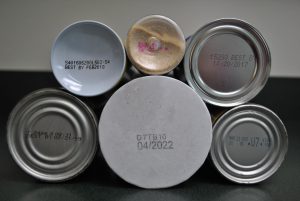
By Samantha Kennedy
UF/IFAS Extension Wakulla County
Ever wonder what all those codes and dates on food packages mean? Different dates are put on different types of food products and it can be very confusing for consumers. Some common types of dates and their meanings are described here.
First of all, it is important to know there is no date upon which a food automatically becomes unsafe to eat. A food is not safe one day and then suddenly spoiled just because it is now the date printed on the package. However, those dates should be heeded in order to handle the food safely and maximize its freshness.
Sell by dates are the dates at which the retailer should sell the product in order to keep the freshest stock on the shelves. While it is recommended the product be pulled from the shelf after this date, it is still legal to sell food products after the sell by date.
Use by dates are generally found on perishable foods such as dairy, meat, poultry, and eggs. It is recommended to use the product on or before the use by date to ensure maximum freshness, especially since the quality of these products declines rapidly over time.
For packaged yeast and refrigerated dough, the use by date reflects how long the product will retain its rising power. After this date, it is still safe to consume the product as long as it does not have an off color or smell.
Best before dates also reflect how long a product will retain its maximum freshness. Unlike use by dates, however, best before dates are found most often on pre-packaged foods such as chips, crackers, and other snacks. Like use by dates, foods can still be safely consumed after this date if they still look or smell fresh.
Packaged on dates are the dates on which products such as fresh meat and poultry are packaged. Most fresh meat products are safe up to three days after packaging as long as they are kept refrigerated. Vacuum-sealed fresh products can last up to seven days.
Can codes are the most confusing date stamps found on food packages. These codes allow manufacturers to track their products in case of events such as a food recall. Most of these codes do not contain a straightforward date and can only be interpreted by the manufacturer.
With the exception of baby formula, which requires a use by date, the Food and Drug Administration do not require the use of freshness dates. Manufacturers voluntarily choose to add these dates to their products. However, this does not relieve them of any responsibility if their product is found to be substandard or is linked to a foodborne illness outbreak.
While these dates are commonly used to determine product safety and freshness, they are not a replacement for sensory input and common sense. If a product has an off color, an off smell, pests, or mold, it needs to be discarded even if it is not past its use by date.
Never taste a food to test if it is safe to eat. Freezing foods can also extend the shelf-life of a product past its use by date, though long-term freezing can affect color, taste, and texture.
One tip for purchasing products with the longest freshness dates is to select items from the back of the shelf. Retailers stock items using the first in, first out principle, with those items closest to their freshness dates in the front. Items in the back have been packaged more recently and therefore have a longer shelf-life.
For more information regarding this and other food safety topics, please call Samantha Kennedy at the UF/IFAS Extension Wakulla County Office by dialing (850) 926-3931.
 0
0
